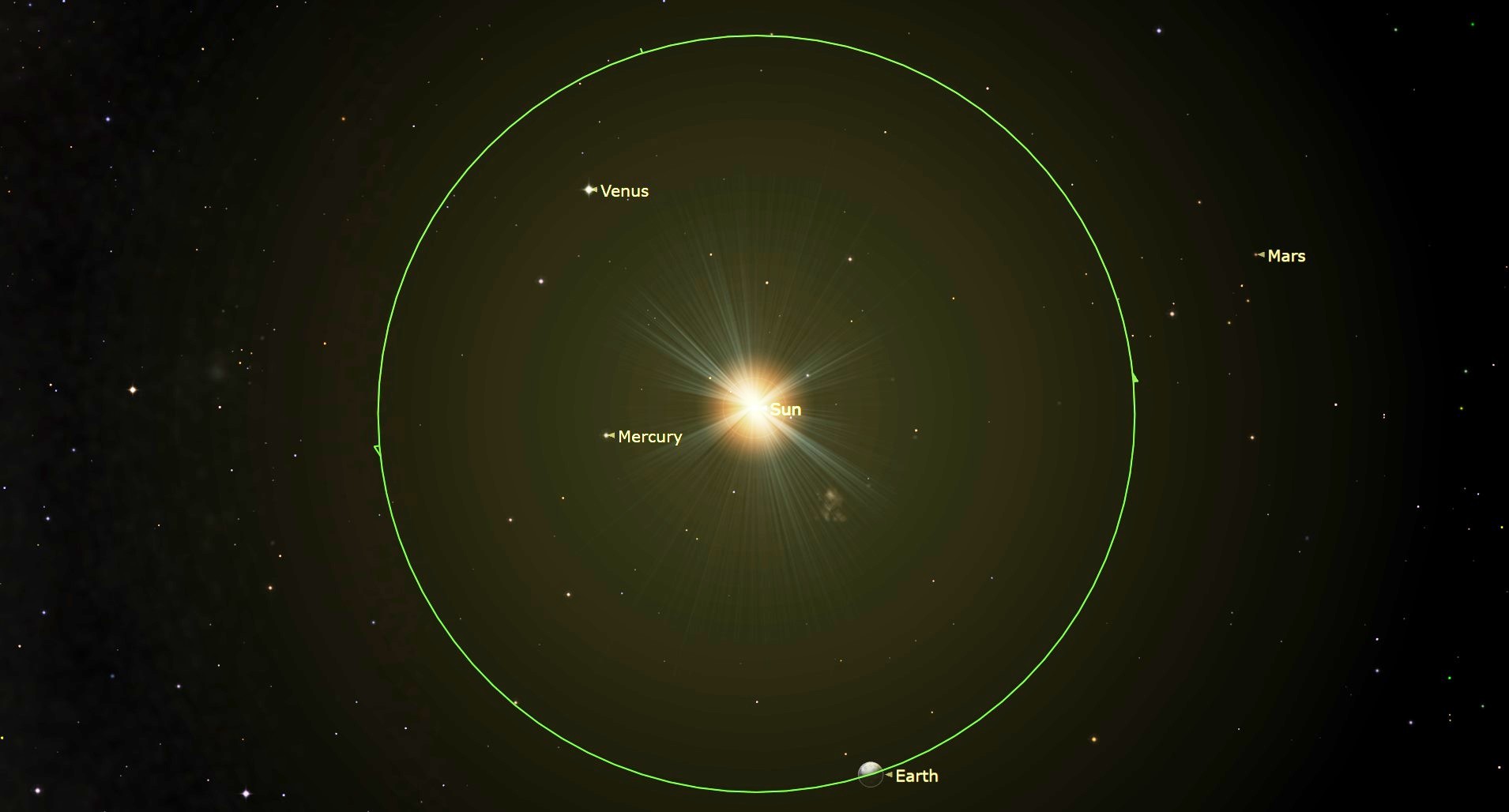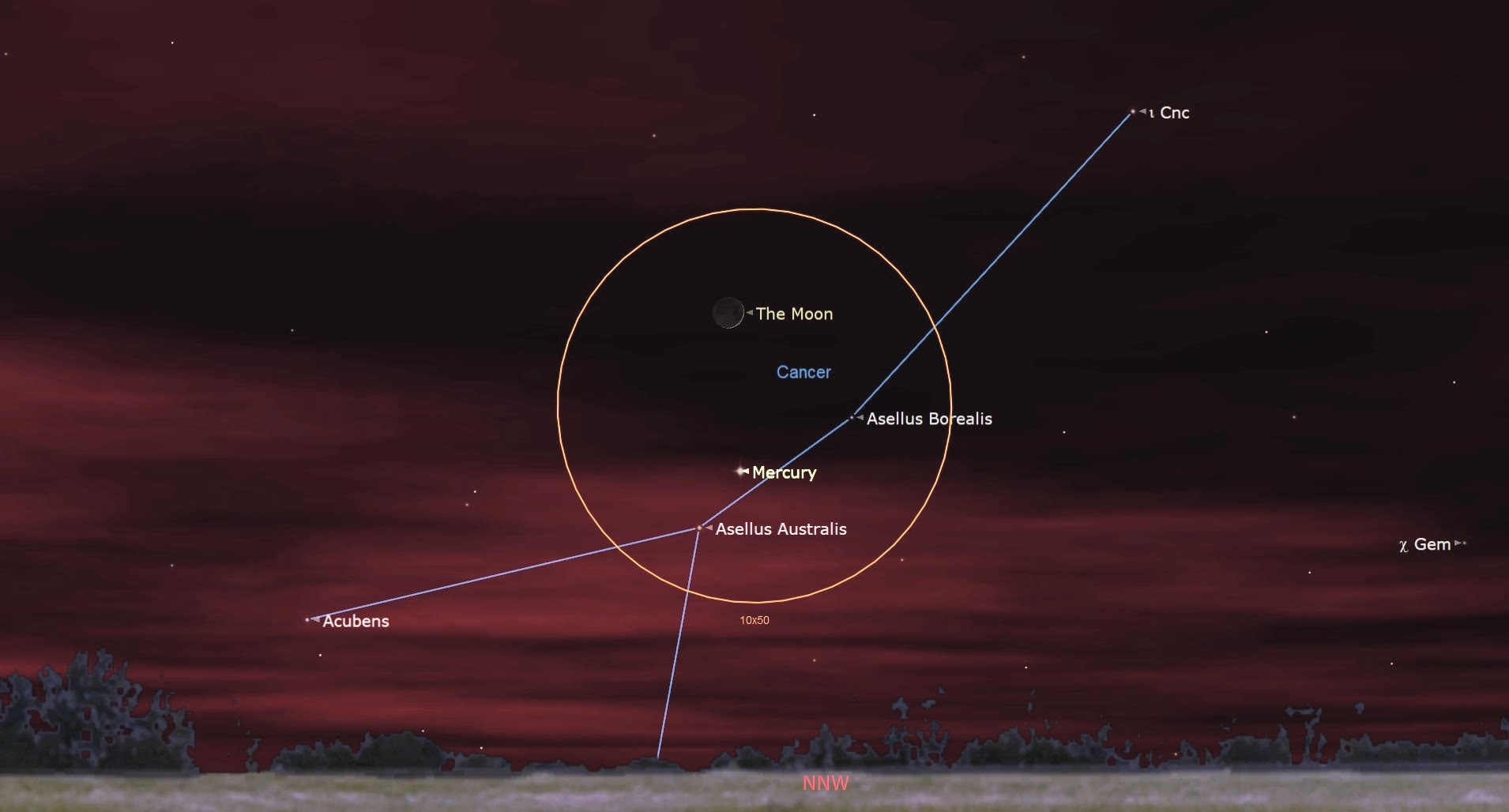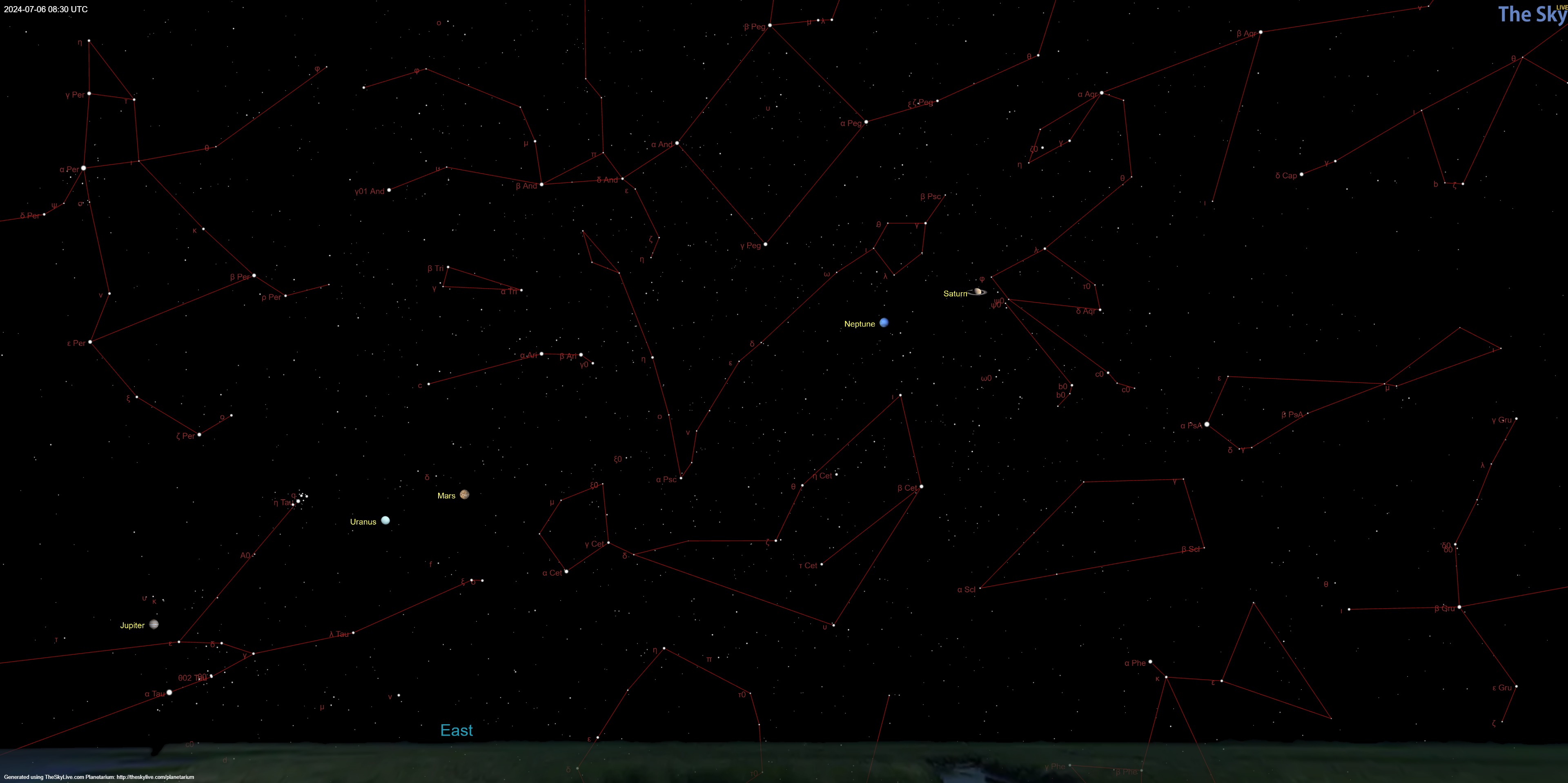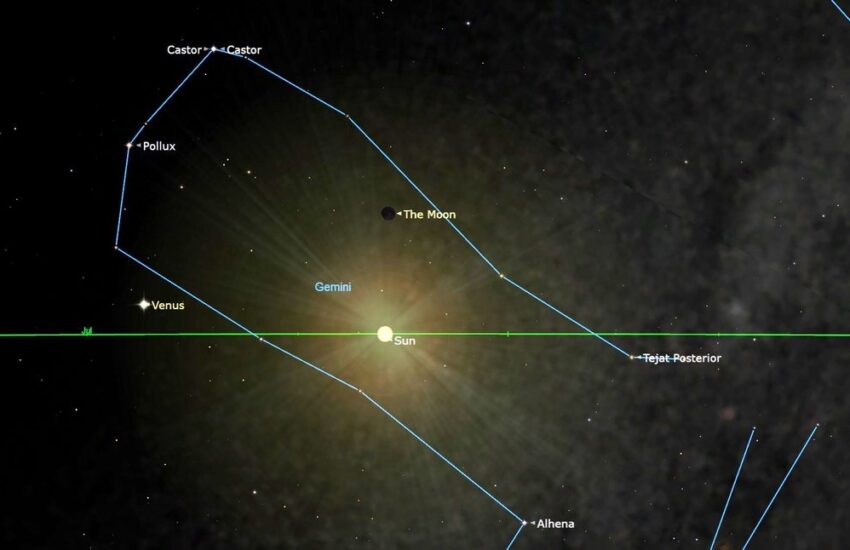The new moon of July 2024 occurs today as Earth reaches its farthest point from the sun, known as aphelion.
The new moon arrives on July 5 at 6:57 p.m. Eastern Time (2257 UTC), according to the U.S. Naval Observatory, and two days later the young moon will make a close pass to Mercury in the evening sky.
Earth reached aphelion today, meaning our was farther away from the sun than at any other period in its yearly orbit. Earth’s orbit around the sun is slightly elliptical, or oval-shaped, meaning our distance from our star can vary up to 3% throughout the year. This small variation isn’t significant enough to be noticeable for most observers.
New moons occur when the moon is directly between the sun and Earth; in many lunar calendar systems they mark the beginning of the lunar month. Technically, the sun and the moon are in conjunction, on the same north-south line that passes through the celestial pole. Lunar phases’ timing is measured by where the moon is relative to the Earth, so a given phase happens at the same time all over the world. Any differences are only because of the time zone one is in – in Melbourne, Australia, for example, the new moon occurs at 8:57 a.m. on July 6.
New moons are invisible unless there is an eclipse; eclipses don’t happen every new moon because the orbits of the moon and Earth aren’t perfectly aligned; they are tilted relative to each other by about 5 degrees. The moon’s shadow then “misses” the Earth most of the time. (The next solar eclipse isn’t until Oct. 2, 2024).

Close pass to Mercury
In the evening hours of July 7, the moon will pass by Mercury as it moves out of the new phase; the thin crescent will be some 3 degrees to the north of Mercury at 2:33 p.m. Eastern time, according to skywatching site In-the-Sky.org. At sunset, when the moon becomes visible, it will be about 16 degrees above the horizon; Mercury will be below the moon. But the planet won’t be really visible at all until about 9 p.m. (sunset on that day is at about 8:29 p.m. in New York; times are similar in cities such as Chicago or Sacramento) and by that time it will only be 8 degrees high, so from anywhere in mid-northern latitudes the conjunction will be a challenge to see – one will need a flat, unobstructed and clear horizon.
Observing the conjunction gets easier as one moves closer to the equator. From lower latitudes (either from the north or south) the ecliptic, or plane of the Earth’s orbit projected on the sky, makes a steeper angle with the horizon. That means planets, which all move within a few degrees of the ecliptic, tend to reach higher altitudes. (It is also why tropical sunsets seem so short, whereas sunsets in higher northern and southern latitudes seem to linger – in the tropics the Sun is approaching the horizon almost straight down, whereas in more northern or southern regions it approaches at a gentler slope).
From Miami the conjunction takes place at 2:33 p.m. local time but both the moon and Mercury will be higher in the sky; the sun sets at 8:16 p.m. local time and at that point the moon is 20 degrees high and Mercury is 18 degrees above the western horizon. By about 8:30 p.m. Mercury should just become visible and it will still be about 12 degrees high, so with a clear horizon with no obstructions one should be able to catch it.
From Bridgetown, Barbados (and similar latitudes) the moon will appear to be to the right of Mercury, and at sunset, at 7:29 p.m. local time, the moon is a full 18 degrees high in the west, by 7 p.m. it is still 14 degrees above the horizon, as is Mercury, and both will be more visible than from the continental U.S.
In the Western Hemisphere the conjunction itself happens in the afternoon, in daylight, but as one moves east the moment of conjunction moves into evening. From Madrid, Spain, the observing challenges are similar to those in New York (the two cities are at nearly the same latitude) but the conjunction occurs at 8:33 p.m. local time.
In the Southern Hemisphere, observing is slightly easier – the days are shorter as it is the austral winter. In Sao Paolo, the sun sets at 5:22 p.m. local time, and while the conjunction happens at 3:33 p.m., still during the day, at sunset the moon will be 18 degrees high in the northwest, and Mercury will appear above and to the left of the moon. Mercury won’t become visible until about 6 p.m. and it will still be about 12 and a half degrees high. In Cape Town, where the conjunction happens at 8:33 p.m. local time – sunset is at 5:51 p.m. and the moon and Mercury set at 7:34 p.m.; about a half hour after sunset the pair is about 13 degrees high in the northwest.

Visible planets
Venus will be emerging into the evening sky, but it will still be largely lost in the solar glare; while it appears a bit higher in the sky at sunset as one gets closer to the equator it is no more than five or six degrees high as the sky starts to darken.
Saturn is the first planet to rise, at 11:40 p.m. on July 5 in New York City. In the constellation Aquarius, which is a fainter star group than many, it will be quite distinct in its region of sky. As the sky starts to lighten by about 4:30 to 5:00 a.m. (the morning of July 6) it will be about 41 degrees above the south-southeastern horizon.
Mars will be prominent in the wee hours of the morning; as the year progresses it rises later and the planet will eventually be lost in the sun’s dawn light. On the night of the new moon (July 5-6) in mid-northern latitudes the planet will rise at about 2 a.m. – it rises at 2:03 a.m. in New York City, and the time will be similar in cities such as Chicago (1:56 a.m. CDT), Denver (2:10 a.m. MDT), and Sacramento (2:18 a.m. PDT). Mars will be in the constellation Aires, and will be easy to spot as Aires is made up of fainter stars.
Jupiter rises after Mars, at 3:07 a.m. EDT in New York. Jupiter is in Taurus, and is to the left and above Aldebaran, the brightest star in that constellation. Aldebaran is noticeably more orange, and twinkles, which makes it easy to pick out the planet which is white-yellow and emits a steady light.
This means that by about 4:30 a.m. local time in mid-northern latitudes the three naked-eye planets further from the sun than Earth will make a kind of line across the sky from the eastern horizon to the right, starting with Jupiter and ending with Saturn.
In the Southern Hemisphere, for example in Melbourne, Australia, (where the new moon is on July 6) the three planets will form a line also, but this time upwards and to the left (as one faces north). Saturn will also be higher in the sky. In Melbourne (and other mid-southern latitude locations) Saturn will rise at 10:22 p.m. Australian Eastern Standard time on July 6; when the planet transits (crossing the north-south line in the sky) at 4:43 a.m. July 7 it will be a full 58 degrees above the northern horizon. Mars rises at 3:22 a.m. AEST, and Jupiter at 4:47 a.m. Jupiter’s position in the sky relative to Aldebaran will be reversed; Jupiter will appear below Aldebaran rather than above (it will still appear to be on the left).

Summer stars
For Northern Hemisphere sky watchers, by about 10 p.m. the Summer Triangle is high in the eastern sky; the “top” star is Vega, the brightest star in Lyra the Lyre, and it is almost at the zenith (about 70 degrees above the horizon). The other two stars in the Summer triangle are Deneb and Altair, both of which are east (to the left) of Vega; from a dark-sky site one can see the Milky Way inside the Triangle. The three stars make a rough right triangle with Altair at the southern end.
Turning left – towards the north one will see the Big Dipper to the left (west) and slightly below Polaris, the pole star. Following the “pointers” (the two stars in the front of the bowl of the Dipper, Dubhe and Merak) to Polaris and continuing straight across you encounter Cepheus, the king, and just below Cepheus is the “W” shape of Cassiopeia, which will be low in the northeast.
In the other direction, follow the handle of the big dipper and “arc to Arcturus” the brightest star in Boötes, the herdsman, and continuing downward you hit Spica, the brightest star in Virgo. Turning south (to the left), one sees the bright red star Antares, the heart of Scorpius, and in darker sky locations looking up (north) from Scorpio one sees Ophiuchus the healer, with Sagittarius and its “teapot” shape to the left of Scorpius.
In the mid-southern latitudes one sees the stars of winter – darkness comes earlier. By 7 p.m. the sky is dark and the Southern Cross is high above the southern horizon, about 65 degrees. To the left of the Cross (east) is Alpha Centauri, also called Rigil Kentaurus, our nearest stellar neighbor. Further east and closer to the horizon is Scorpio, though upside-down (from the point of view of a northern hemisphere observer) and very high in the sky; Antares is a full 47 degrees in altitude by 7 p.m.
In the southwest, the ship’s keel, Puppis, is setting and marked by Canopus, about 20 degrees above the southwestern horizon. Canopus is the second-brightest star in the night sky after Sirius. In the same region of sky to the left (towards the south) are the Large Magellanic Cloud and Small Magellanic Clouds, two satellite galaxies of the Milky Way.

